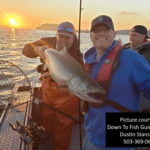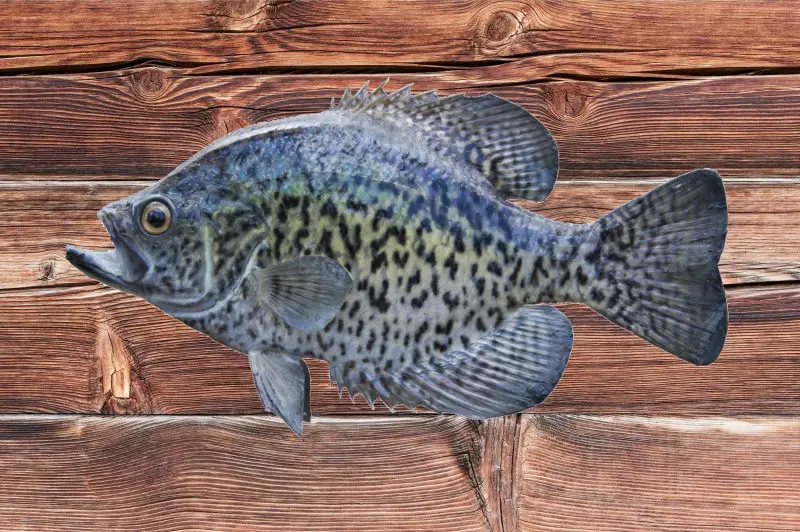When you start to fish a new species of fish, it helps to have a few pointers to head you in the right direction. These tips could include a fishing line, a lure, or where to fish and at what time.
In this article, we have a list of tips to share with you. We will break down these tips into four groups, gear, bait, areas, and technique.
Gear
A light pole will serve you better for crappie and small panfish like blue gill so you can see a soft bit. Also, crappie and other similar fish are softer in the mouth and jaw, so a light pole helps prevent you from ripping the hook. Something like a Zebco Crappie Fighter combo is a great choice for beginners.
Using light line is a must because crappies are very line shy. Typically, I load all my poles with 6-pound ultra-green monofilament and then use a six-foot 4-pound clear fluorocarbon bumper to the jig or lure. Going light will give you the best chance of getting a bite.
Using a slip bobber above the bumper is a great way to control your depth, especially when targeting 6 to 12 feet down. Beads and bobber stops are great with sliding boobers and cast-a-bubbles.
Small jigging spoons are great for triggering a bite and are easy to use when you have located a school of crappie. Cast the jig to the opposite side of the school, tighten the line and let it sink into the middle of the school. Once you are there, lightly jig the spoon with a jerking action, then reel one crank. They tend to bite on the drop.
Bait
When looking for schools of crappie, free spooling minnows can help locate and attract schools of fish. Once you have found the crappie, add bobbers and try 1-inch grubs suspended on a #6 hook or smaller.
When fishing docks or outcrops, cornmeal can attract minnows. Spread a small hand full of cornmeal as far as you can, then take a 5-minute break. Minnows and bait fish will start to feed and attract crappie. Then it will be the perfect time to cast an ultralight rooster tail to the opposite side where you spread the cornmeal.
Also, don’t forget scent attractants on your lures. Crappie like a variety of small organisms, so a scent to mimic things like shrimp is always a good addition.
Timing
Avoid planning a fishing trip when there is a clear night sky with a full moon. Crappie and other fish tend to feed all night when the moon provides light so they can target bugs on the surface.
Sunrise and sunset are the best time to target crappie. When the sun is high, most fish tend to get lower in the water column and find shelter from larger predators.
Pressure changes can affect different fish in different ways. Crappie become more active right before bad weather comes in. If you have good weather information on a rainstorm’s arrival, the two hours before it starts can be a great bite. However, never fish in lightning storms!
Areas
When you think of where to target crappie, you want to think of the season. During spring, the fish will be higher in the water column seeking warmer water and feeding on other organisms in the warm water.
During the seasonal transition, still backwater coves and slow creek deltas are good places to find feed crappie, but later in the day, these fish will move into deeper water.
As summer starts to warm up the water, the fish can be found in covered areas like channels under bridges, trees, docks, and pilings. In the fall, crappie will head for shallower areas to spawn, docks, and submerged trees area favorites.
When fishing an impoundment, do not skip the dam or weir. Typically, there are a lot of organisms that live on the surfaces. These little things attract minnows that attract the larger fish you want to catch.
Don’t skip places like boat ramps and public fishing docks. These places can be hot spots on weekdays when pressure is light. The fish will come around looking for discarded leftover bait that weekend fishers will toss in the lake at the end of their fishing day. Also, dock and boat ramps can be a great place to chum for crappie.
Finally, when you locate a crappie school, always target the top of the school first, as the largest fish tend to be on the top and the edges. Smaller crappie will cluster in the middle and the bottom of schools for protection and are happy eating scraps that are too small for the big fish.
Technique
We have talked a little about techniques, but we want to share a few tips that can improve your hook-to-land ratio. Most of these tips are for retrieve fishing, but that is where many beginners need a few pointers.
Keep your rod tip down when you are reeling in a fish. In a perfect world, you should hold your rod sideways at a 45-degree angle from the fish, level with the water surface. At this angle, you will be able to maintain constant pressure on the fish without jerky the hook out or breaking your rod.
When you are retrieving a spinner, spoon, or other lure, keep your rod tip pointed at the lure until you feel a bite. Once you get a bite, set the hook by turning your wrist to lift the pole straight up to a 45-degree angle or slightly greater. Then point your pole to the side at 45 degrees, as discussed above.
Keep your line tight when retrieving your lure so you can feel the bite. Of course, you want to retrieve your line at a slow speed to let the fish hit the bait, but if you let your line slack, it makes it hard to feel when smaller fish hit.
Finally, keep your fishing line close to the water when it is windy. As you retrieve your lure, dip your pole tip into the water, which will help keep your line tight. The wet fishing line is heavier, helping resist the wind. Also, the wind will have no effect when the line is underwater.
Conclusion
I hope that these tips will help you get started with crappie fishing. By far, my best advice is to get out there and put a line in the water.
You will learn about Crappie fishing through trial and error, but no matter what, the outdoors will make your life better.





